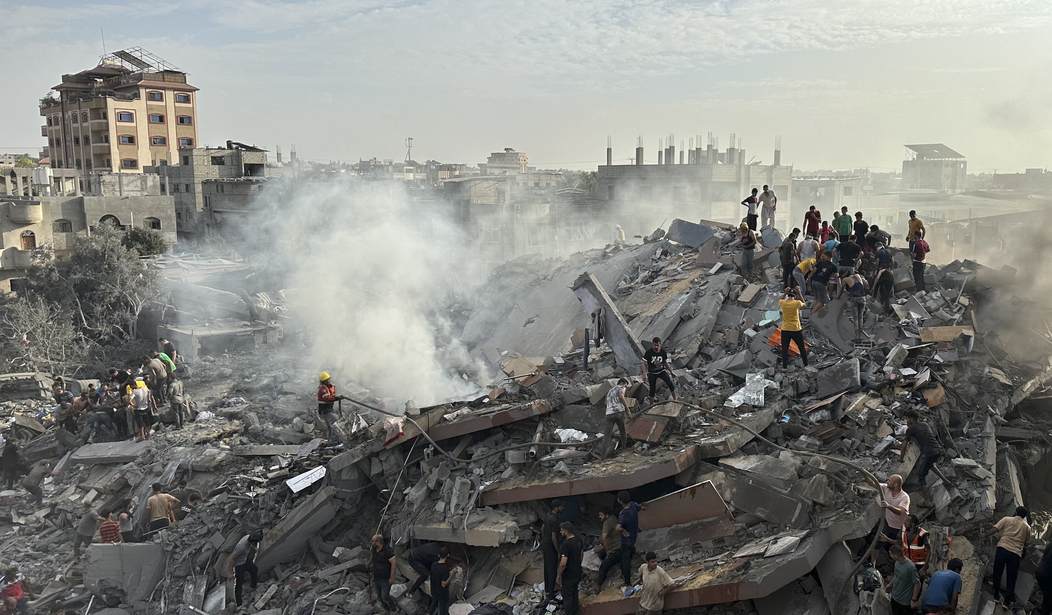Israel's Air Force carried out a strike on the Jabalia refugee camp Tuesday that resulted in the destruction of a Hamas command bunker and the death of one of the senior planners of the October 7 terror attack. The attack also killed an unknown number of Gazans. Those deaths have become the focal point of international outrage and threaten the legitimacy of Israel's punitive expedition against Hamas.
According to the IDF spokesman, the attack targeted a Hamas bunker complex located beneath the Jabalia camp.
In a statement, the IDF said: 'A short while ago, IDF fighter jets, acting on ISA intelligence, killed Ibrahim Biari, the Commander of Hamas' Central Jabaliya Battalion. Biari was one of the leaders responsible for sending 'Nukbha' terrorist operatives to Israel to carry out the murderous terror attack on October 7th.'
There is no reason to doubt this was the target. Survivors report sinkholes opening and the ground collapsing around them. Hamas has acknowledged the death of the terrorist, Biari, and of the presence of an underground operations center. And natural sinkholes are not found in Gaza.

Images from the site show a massive collapse of terrain.
This is what US aid to Israel looks like pic.twitter.com/8cFFlzFBQI
— Ubai (@UbaiAboudi) November 1, 2023
There are three craters that mark the bomb strikes. The strikes are very close together, indicating they were precision-guided munitions. Those craters are surrounded by massive failure of terrain.
After dropping six tons of explosives on Jabalia camp yesterday afternoon, lsraeli warplanes strike another residential block in the same area, killing and injuring tens of Palestinians. pic.twitter.com/SZgrbLHqbG
— TIMES OF GAZA (@Timesofgaza) November 1, 2023
(Click on the top left image in the tweet for a clearer view of it.)
Note the building at the left, adjacent to a bomb crater, is not knocked down, while other buildings nowhere near a visible crater have disappeared. This corroborates the structural collapse of buildings reported by survivors rather than indicating bomb damage. All of this points to the existence of an underground complex like those Hamas has showcased to its allies.
Hamas terrorist give RT a tour of their tunnel network in Gaza - called the Metro. Video shows Hamas fighters with weapons (ATGMs, RPGs, Snipers, machine guns) waiting in advanced tunnels to conduct surprise counterattacks on @IDF Have power, fuel, other services. pic.twitter.com/CrAKlPNUqM
— John Spencer (@SpencerGuard) October 31, 2023
Various sources claim that the IAF dropped six tons of munitions. This would be the approximate weight of three GBU-28/GBU-72 "bunker buster" bombs designed to penetrate hardened, below-ground targets.
The point of this is to establish that 1) this was a strike on a high-value military target, not a random terror bombing, and 2) the number and type of weapons used were proportional to the target.
The dust had hardly settled when the "Gaza Health Ministry" was claiming hundreds of dead and wounded. Much like they immediately claimed "500" dead from an IAF strike on a crowded hospital that turned out to be a malfunctioning Hamas rocket hitting a parking lot; see REPORT: 'Palestinian Authorities' Grossly Overreported Hospital 'Bombing' Deaths. And there is always the Pali-wood spectacle of corpses inexplicably using cell phones.
When the "Gaza Ministry of Health" tells you how many casualties there are... pic.twitter.com/8o2WCQptM1
— The Mossad: Satirical, Yet Awesome (@TheMossadIL) October 26, 2023
The Jabalia refugee camp is a densely packed urban area.

CREDIT: Google Maps
Though the name "refugee camp" gives an image of impermanence, Jabalia has high-rise buildings and high-end retail outlets.
Mohammad and Mahmoud takes us to see the #Ramadan festive night atmosphere in #Gaza City, first in Jabalia "refugee camp", then along Gaza beach road, then Naser Street, ending up at one of Gaza's popular Equestrian Clubs. #TheGazaYouDontSee #Palestine https://t.co/hbtHYdSt8G pic.twitter.com/1mJSUTNWQy
— Imshin (@imshin) April 12, 2023
It has been a hotbed of Hamas activity dating back at least to the First Intifada in 1987.
Knowing that a legitimate military target was hit is only part of the equation. The Geneva Conventions imposes obligations on a combatant who is attacking an area with a civilian population. One of those is giving advance warning so that civilians may move.
Indeed, a customary duty to warn has consistently been included in expert manuals and studies dealing with targeting (see, e.g., AMW Manual, commentary to rule 37; Tallinn Manual 2.0, rule 120; ILA Conduct of Hostilities study, p. 384-388). Further confirming its customary character, military manuals of non-Additional Protocol I States include a warning requirement. For instance, the DoD Law of War Manual provides, “Unless circumstances do not permit, effective advance warning must be given of an attack that may affect the civilian population” (§ 5.11.5). Israel does not dispute the rule’s customary status.
A requirement to warn is likewise customary in non-international armed conflict. The ICRC’s Customary IHLstudy takes this position (rule 20), as did the International Group of Experts that drafted Tallinn Manual 2.0 (rule 120, para. 2). The International Criminal Tribunal for the former Yugoslavia also found Articles 57 and 58 (see discussion below) of Additional Protocol I to reflect customary law (Kupreškić, para. 524).
We know that Israel has given a generic warning to Gazans to leave. That does not meet the standard required under international law, but it is a necessary first step. According to PBS's NewsHour program, that warning had some effect.
In the Northern Gaza Strip, the beginning of a mass exodus, the streets filled with confusion after Israel's military gave residents 24 hours to leave and relocate south.
Israel's designation of evacuation routes from North to South Gaza further met the requirements of international law.
International law also requires a direct warning be given to civilians in the area of an imminent attack if it is feasible to do so.
We also know Israel has used a warning method called "roof knocking."
The Israel Defense Forces (IDF) have seemingly stopped the “knock on the roof.”
The euphemism describes a military tactic first developed in 2009 and used in several conflicts since then.
How it works: IDF forces will alert a building’s occupants that they are targeting the structure for an airstrike by dropping a small, non-explosive munition on the roof before a larger strike is executed. Its objective is to minimize civilian casualties by allowing for evacuation in buildings where militant groups keep rockets or ammunition stashed.
This indicates that Israel is following its standard, decades-long practice of how to warn civilians. So, how does that process work?
To conduct the phone warnings, the IDF employs a specialized team of trained personnel who run a “phone bank” with the sole purpose of contacting individuals who might be affected by a strike. The calls are in some cases extremely precise. For instance, the warning may be that a strike will occur at a specified time. Live operators make some phone warnings, while others consist of generic pre-recorded messages. The personnel in the warning cell speak Arabic fluently, have received cultural training on the civilian population in the target area, and whenever feasible, use all-source fused intelligence to focus on specific individuals who might be at risk. For example, understanding Palestinian culture and family structures, the warning cell may try to contact the male head of a family in a particular apartment building, knowing that he will effectively disseminate the warning to other family members. If a minor or a female answers the phone call, the warning cell attempts to speak to the head of the family. When several buildings in a particular area are targeted, the warning cell may also contact a local civilian official or an informal community leader who will be able to spread the warning effectively and insist on obedience.
"Roof knocking" happens after all other warnings have been given.
As a rule, Israel's warning methods represent "state of the art" in warning civilians of attack.
Israel’s 2014 operations in Gaza, and the extensive efforts to provide such warnings, have elevated the discourse on this warnings precaution to unprecedented levels: some worry that the Israeli Defense Forces (IDF) created an unrealistically high bar on when and how to provide warnings; conversely, some condemn the IDF because the warnings did not produce their intended effects; finally, some suggest that the extent of warnings were the result of policy decisions, and not legal obligation.
As there is no reason to believe that the IDF departed from its long-standing warning procedures in this one case, and we know in extremis warnings are taking place, it is a fair assumption that the residents in the area were warned before the attack and didn't heed the warning. That is not unusual. It is also possible that a judgment was made that alerting residents to an imminent attack was not feasible due to the target moving or the danger of human shields being deployed.
A particular obstacle to warnings in Gaza is Hamas’s practice of human shielding. In the past, there have been many instances where civilians have moved voluntarily to the vicinity of targets following IDF warnings. Even more egregious is the use of involuntary human shields. With Hamas holding 200 hostages, the potential for their movement to locations regarding which the IDF issues a specific warning is high. When a warning is likely to result in human shielding, the situation amounts to one in which a warning is not feasible.
...
As has been illustrated in Gaza, civilians do not always heed warnings. This may be because they prefer to remain in place, lack the capacity to move, wish to demonstrate support for Hamas, or fear Hamas’s retaliation if they leave. Their motivation is irrelevant; they remain civilians whom the IDF must factor into its proportionality calculations, as well as into its assessment of whether other precautions to minimize harm to them, such as the selection of a different weapon, are feasible.
The defender has obligations, too. The defender can't use civilians as shields. The defender can't co-locate defensive positions inside civilian areas to avoid attack. The defender has the same obligation as the attacker to remove civilians from areas likely to be attacked.
Hamas locating a bunker complex in a residential area without removing the civilian population is a war crime. If Hamas refused to allow civilians to evacuate the area, that would be a war crime. Plus, we know it is Hamas's public policy to ensure as many Gazan civilians are killed as possible; Hamas Leader Says They 'Need the Blood of Women, Children, and the Elderly' to Inspire Terrorist Attacks. Any innocent blood shed in Tuesday's attack is on Hamas's hands.













Join the conversation as a VIP Member